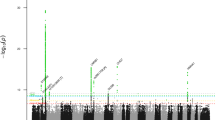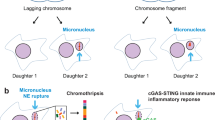Abstract
THE demonstration of sex chromatin has become an important aspect of human genetics, both for practical reasons, and for the purpose of establishing the theoretical relationship between sex chromatin and the X-chromosome. The term ‘sex chromatin’ comprises two superficially dissimilar structures : (1) the Barr body, present in epithelial and other tissue cells ; (2) the drumstick of the polymorphonuclear leucocytes. A drumstick consists of a small nuclear mass, about 1.5µ in diameter, which is attached to the body of the nucleus by means of a thin filament1 (Fig. 1). Drumsticks may occur in any of the three types of polymorphonuclear leucocytes, but for practical purposes only those present in neutrophils are considered. It is now generally accepted that the drumstick is an expression of an X-chromosome in cells in which more than one are present2,3 and this means that drumsticks and Barr bodies are equivalent structures. Nevertheless, the interpretation of drumsticks in patients with chromosomal abnormalities has sometimes given rise to difficulties, which have not been encountered in relation to Barr bodies. For example, patients with Klinefelter's syndrome have an incidence of drumsticks which is lower than that found in normal females4 whereas the frequency of Barr bodies is not decreased. Again, a considerable proportion of epithelial cells in patients with three X chromosomes contain two Barr bodies, but the occurrence of two drumsticks within the same cell must be regarded as a rarity5–7. These discrepancies between drumsticks and Barr bodies are due to at least three causes : (1) low incidence of drumsticks, which in normal women is on the average less than three per 100 neutrophils ; (2) wide variation in the frequency of drumsticks in different women ; (3) the fact that the incidence of drumsticks is to some extent determined by the degree of segmentation of the nuclei of the polymorphonuclear leucocytes1.
This is a preview of subscription content, access via your institution
Access options
Subscribe to this journal
Receive 51 print issues and online access
$199.00 per year
only $3.90 per issue
Buy this article
- Purchase on Springer Link
- Instant access to full article PDF
Prices may be subject to local taxes which are calculated during checkout
Similar content being viewed by others
References
Davidson, W. M., and Smith, D. R., Brit. Med. J., ii, 6 (1954).
McKusich, V. A., Quart. Rev. Biol., 37, 69 (1962).
Sohval, A. R., Physiol. Rev., 43, 306 (1963).
Davidson, W. M., and Smith, D. R., in Symp. Nuclear Sex, edit. by Smith, D. R., and Davidson, W. M. (London, 1958).
Jacobs, P. A., Baikie, A. G., Court Brown, W. M., MacGregor, T. N., Maclean, N., and Harnden, D. G., Lancet, ii, 423 (1959).
MacLean, N., Lancet, i, 1154 (1962).
Mittwoch, U., Cytogenetics, 2, 24 (1963).
Maclean, N., Mitchell, J. M., Harnden, D. G., Jacobs, P. A., Baikie, A. G., Williams, J., Buckton, K. A., Court Brown, W. M., McBride, J. A., Strong, J. A., Close, H. G., and Jones, D. C., Lancet, i, 293 (1962).
Hamerton, J. L., Jagiello, G. M., and Kirman, B. H., Brit. Med. J., i, 220 (1962).
Delhanty, J. D. A. (private communication).
Lele, K. P. (private communication).
Wintrobe, M. M., Clinical Hæmatology, fifth ed. (London, 1961).
Turpin, R., and Bernyer, G., Rev. Hém., 2, 189 (1947).
Shapiro, A., J. Ment. Sci., 95, 689 (1949).
Lüers, T., and Lüers, H., Arztl. Forsch, 8, 263 (1954).
Mittwoch, U., J. Ment. Def. Res., 1, 26 (1957).
Mittwoch, U., Acta genet. med. Gem., Suppl. sec. 131 (1959).
Mittwoch, U., in Symp. Human Chromosomal Abnormalities, edit. by Davidson, W. M., and Smith, D. R. (London, 1961).
Krivit, W., and Good, R. A., Amer. J. Dis. Child., 94, 289 (1957).
Stewart, A., Webb, J., and Hewitt, D., Brit. Med. J., ii, 1495 (1958).
Holland, W. W., Doll, R., and Carter, C. O., Brit. J. Cancer, 16, 177 (1962).
Mamunes, P., Lapidus, P. H., Abbot, J. A., and Roath, S., Lancet, i, 26 (1961).
Bousser, J., and Tanzer, J., Nouv. Rev. franç. Hémat., 3, 194 (1963).
Tough, I. M., Court Brown, W. M., Baikie, A. G., Buckton, K. E., Harnden, D. G., Jacobs, P. A., and Williams, J. A., Lancet, ii, 115 (1962).
Schade, H., Schoeller, L., and Schultze, K. W., Med. Welt., 2690 (1962).
Lewis, F. J. W., Poulding, R. H., and Eastham, R. D., Lancet, ii, 306 (1963).
Alter, A. A., Blood, 22, 165 (1963).
Trubowitz, S., Kirman, D., and Masek, B., Lancet, ii, 486 (1962).
King, M. J., Gillis, E. M., and Baikie, A. G., Lancet, ii, 661 (1962).
O'Sullivan, M. A., and Pryles, C. V., New Engl. J. Med., 268, 1168 (1963).
Wiedemann, H., in Symp. Nuclear Sex, edit. by Smith, D. R., and Davidson, W. M. (London, 1958).
Tonomura, A., Toyofuko, Y., and Matsunaga, E., Jap. J. Hum. Genet., 7, 60 (1962).
Kiossoglou, K. A., Garrison, M., jun., Walker, A., and Wolman, I. J., J. Ment. Def. Res., 7, 69 (1963).
Author information
Authors and Affiliations
Rights and permissions
About this article
Cite this article
MITTWOCH, U. Frequency of Drumsticks in Normal Women and in Patients with Chromosomal Abnormalities. Nature 201, 317–319 (1964). https://doi.org/10.1038/201317a0
Issue Date:
DOI: https://doi.org/10.1038/201317a0
This article is cited by
-
Klinefelter's syndrome and incontinentia pigmenti Bloch-Sulzberger
Human Genetics (1977)
-
Nuclear lobe count and incidence of drumsticks in Indian children with down’s syndrome
The Indian Journal of Pediatrics (1965)
-
Drumsticks in the leucocytes of primates
Experientia (1964)
Comments
By submitting a comment you agree to abide by our Terms and Community Guidelines. If you find something abusive or that does not comply with our terms or guidelines please flag it as inappropriate.



